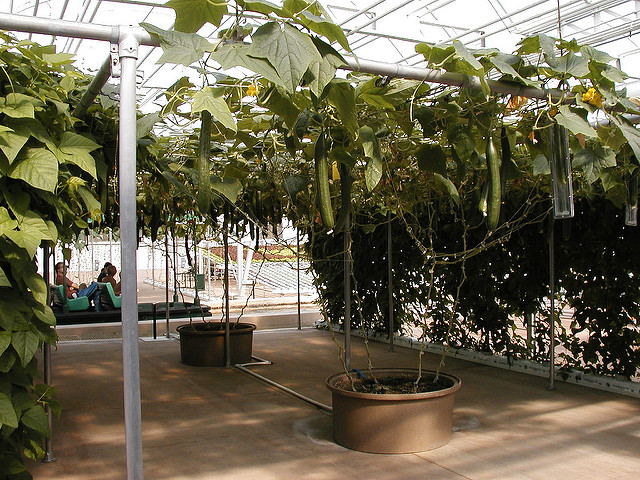Flood and Drain Systems, continued
This is page 8 of our eight page series on hydroponic flood and drain systems. Click any of the links below to jump to that page.
Page 1 Page 2 Page 3 Page 4 Page 5 Page 6 Page 7 Page 8

One more variation on a hydroponic flood and drain system theme. These cucumbers are being grown in groups of 4 vines per container, then the vines are trellised onto a large square framework which gives each individual plant plenty of light, air and space. By trellising the plants well above ground, the fruits hang down and are very easy to see and harvest. Also note the row of another plants, possibly tomatoes, growing in a continuous slab just on the other side of the cucumber vines. While it's impossible to tell for certain from the photo, both approaches could conceivably be flood and drain. The irrigation solution must be delivered to the containers (or slabs) in some way, then drained away to a reservoir below or beyond. The groupings of vines at the base, then spread out on large vertical trellises, provides easy working conditions and comfortable growing conditions.
More Information
Quite a lot of research is going into hydroponic systems design, operation, cost effectiveness and crop productivity. I tried to find papers and web pages which focused just on flood and drain systems, but most of the available resources covered multiple hydroponic systems. I decided to go ahead and include the better ones even if/when they discussed other approaches. If nothing else, it'll provide some comparisons between flood and drain systems and other hydroponic methods.
This first resource is actually a compendium of papers gathered on one page at the National Agricultural Library's Alternative Farming Systems Information Center. Their Hydroponics page provides a wide sampling of hydroponic systems and methods, along with related topics such as greenhouse management, organic certification of hydroponic operations and business opportunities within hydroponics.
The University of Massachusett's Center for Agriculture, Food and the Environment has a Hydroponics Greenhouse Production Resources section. Like the first link, this page is a compilation of research papers, information bulletins and topic-specific reports on various aspects of hydroponic systems, often located within Massachusetts. Topics include disease control, organic fertilization of hydroponic crops, commercial greenhouse construction, best practices for greenhouse irrigation management, and various general guides from a variety of other universities. The page also lists regional resources which may be of particular value for growers in New England and the Mid Atlantic states.
Cornell University has an entire department devoted to Controlled Environment Agriculture, which is an umbrella term for hydroponic systems within a fully controlled environment, to provide optimal lighting, temperature and humidity. The Intro Page on their department website includes too many specialty topics to list here, but topics range from hydroponic business considerations, nutrient deficiency within specific crops, greenhouse management, Excel calculators for nutrient balancing, etc.
We'll keep adding more sources of information as we find them, particularly those which focus on flood and drain systems.
Click any of the links below to jump to that page.